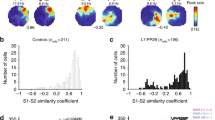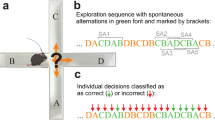Abstract
The contribution of the cerebellum to the non-motor aspects of spatial navigation is now established, but the mechanisms of its participation remain unclear. The L7-PKCI mouse model, in which inhibited PKC activity suppresses parallel fiber-Purkinje cell long-term depression (LTD), provides the opportunity to study their spatial abilities in the absence of any motor impairment. L7-PKCI mice are deficient in the spatial but not the cued version of the watermaze task. Their performances are preserved when alleys guide their trajectories in the starmaze task, suggesting that cerebellar PKC-dependent mechanisms are required for the production of an optimal trajectory toward a goal. Furthermore, electrophysiological recordings in freely moving L7-PKCI mice revealed that their hippocampal place cell properties are affected when they have to rely on self motion information: in the absence of external information as well as in a conflicting situation between self-motion and external information. This suggests that the cerebellum is involved in the processing of self-motion information and is required for the construction of the spatial representation in the hippocampus.


Similar content being viewed by others
References
Colombel C, Lalonde R, Caston J. The effects of unilateral removal of the cerebellar hemispheres on spatial learning and memory in rats. Brain Res. 2004;1004:108–15.
Goodlett CR, Hamre KM, West JR. Dissociation of spatial navigation and visual guidance performance in Purkinje cell degeneration (pcd) mutant mice. Behav Brain Res. 1992;47(2):129–41.
Gandhi CC, Kelly RM, Wiley RG, Walsh TJ. Impaired acquisition of a Morris water maze task following selective destruction of cerebellar purkinje cells with OX7-saporin. Behav Brain Res. 2000;109(1):37–47.
Rondi-Reig L, Le Marec N, Caston J, Mariani J. The role of climbing and parallel fibers inputs to cerebellar cortex in navigation. Behav Brain Res. 2002;132(1):11–8.
Rondi-Reig L, Burguière E. Is the cerebellum ready for navigation? Progress in Brain Research. 2004. p. 201–12.
De Zeeuw CI, Hansel C, Bian F, Koekkoek SK, van Alphen AM, Linden DJ, et al. Expression of a protein kinase C inhibitor in Purkinje cells blocks cerebellar LTD and adaptation of the vestibulo-ocular reflex. Neuron. 1998;20(3):495–508.
Burguière E, Arleo A, Hojjati MR, Elgersma Y, De Zeeuw CI, Berthoz A, et al. Spatial navigation impairment in mice lacking cerebellar LTD: a motor adaptation deficit? Nat Neurosci. 2005;8(10):1292–4.
Burguière E, Arabo A, Jarlier F, De Zeeuw CI, Rondi-Reig L. Role of the cerebellar cortex in conditioned goal-directed behavior. J Neurosci. 2010;30(40):13265–71.
Rochefort C, Arabo A, Andre M, Poucet B, Save E, Rondi-Reig L. Cerebellum Shapes Hippocampal Spatial Code. Science. 2011. p. 385–9.
Rochefort C, Lefort JM, Rondi-Reig L. The cerebellum: a new key structure in the navigation system. Front Neural Circ [Internet]. 2013;7(March):35.
Rondi-Reig L, Paradis AL, Lefort JM, Babayan BM, Tobin C. How the cerebellum may monitor sensory information for spatial representation. Front Syst Neurosci. 2014;8:205.
Conflict of Interest
The authors declare that they have no conflict of interest.
Author information
Authors and Affiliations
Consortia
Corresponding author
Additional information
Christelle Rochefort and Laure Rondi-Reig contributed equally to this work.
Rights and permissions
About this article
Cite this article
Lefort, J.M., Rochefort, C., Rondi-Reig, L. et al. Cerebellar Contribution to Spatial Navigation: New Insights into Potential Mechanisms. Cerebellum 14, 59–62 (2015). https://doi.org/10.1007/s12311-015-0653-0
Published:
Issue Date:
DOI: https://doi.org/10.1007/s12311-015-0653-0




